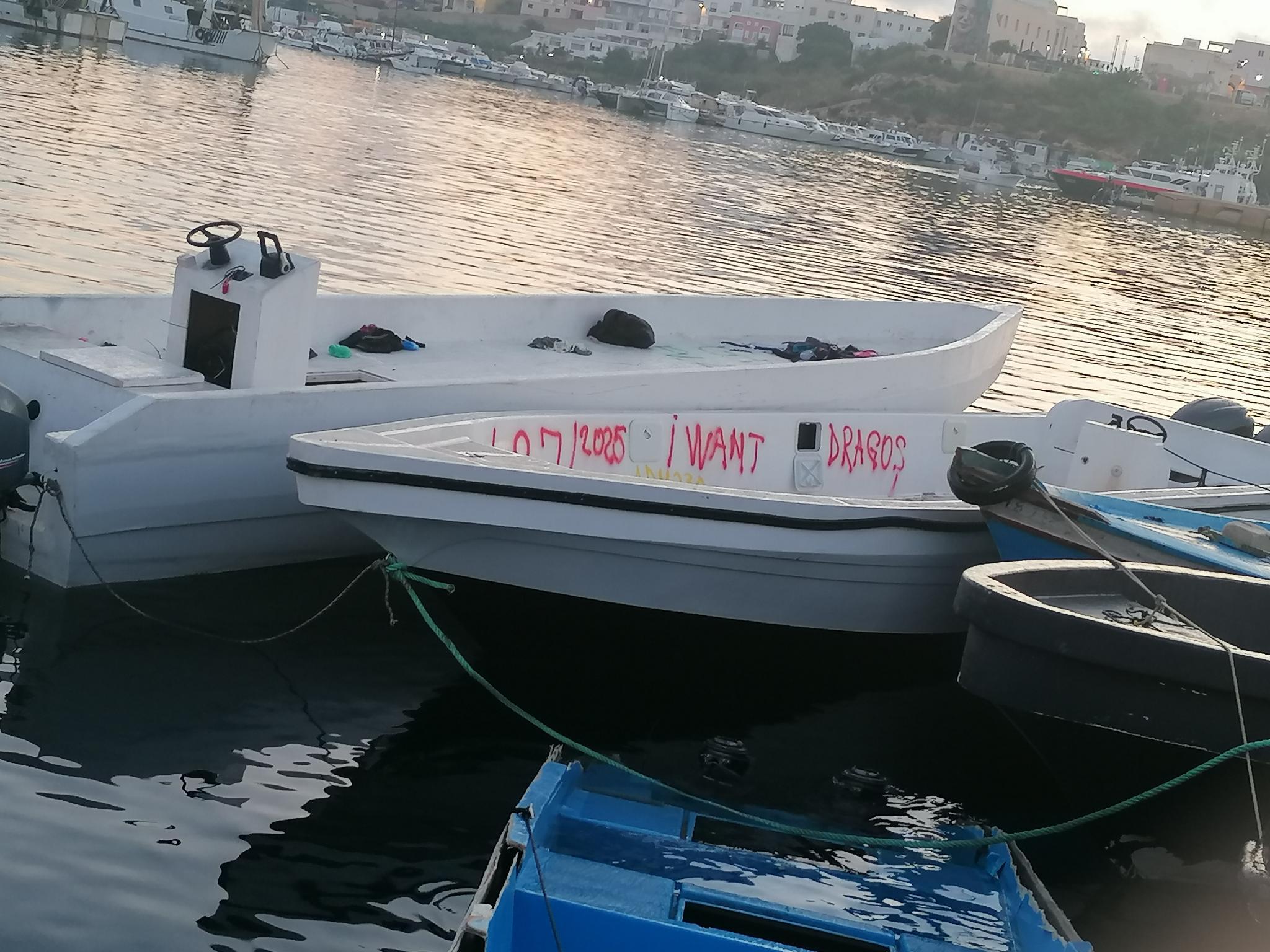
Boats of people on the move in the port of Lampedusa. Source: Alarm Phone
Intro
In the first half of 2025, Alarm Phone was alerted to 334 boats in distress in the central Mediterranean Sea. In the prior six months, July to December 2024, we had been alerted to 482 boats on this migration route. Overall, according to data by the UNHCR, arrivals to Italy via Libya and Tunisia stood at 33,631 people at the end of June 2025, and therewith at a slightly higher level to the year prior, when 26,015 arrived in the first six months of 2024.
With departures from Tunisia decreasing due to repressive border enforcement practices by the country’s authoritarian regime, often forcing intercepted people to the desert by the Algerian border, Libya is the key departure place for boats in the central Mediterranean region. But also from Libya, many are hindered from escaping through interception measures by the EU-supported so-called Libyan coastguard. In the first half of 2025, the IOM estimates that about 12,000 people were intercepted to Libya. The organisation also estimates that 588 people have died in this period of time. We should emphasise, however, that any statistical count of interceptions and deaths can only ever be rough estimates that need to be treated with caution. Many interceptions and deaths or disappearances are never documented.
We have witnessed first-hand the continuous movements on the route from Libya toward Crete and Gavdos in Greece. Already in 2024, this route had seen a remarkable increase – Refugee Support Aegean documented the arrival of 5,161 people last year. In 2025, with 7,336 people arriving in just the first six months of this year, this route continued to be a key corridor of escape from Libya. In response, the Greek government has halted asylum processing in July and has announced mass deportation measures.
The civil fleet has continued to carry out rescues and remains resilient, despite the ongoing assault on their solidarity at sea. According to the Civil Maritime Rescue Coordination Centre, of which Alarm Phone is a member, more than 7.000 people were rescued by the civil fleet in the first six months of 2025.
In this analysis, we provide a comprehensive chronology of the first half of 2025, offering in great detail an account of developments as they unfolded in the central Mediterranean Sea. As nobody else is doing so, we need to create our own archive of migrant struggles and acts of solidarity. We will continue in our struggle alongside people on the move and document the border violence that they face. In our daily practice, we struggle against borders, for ferries, not Frontex, and the freedom of movement for all.
Chronology: January to June 2025
January
In January 2025, Alarm Phone was alerted to 45 boats in distress, among them 44 departing from Libya and one from Tunisia. NGO vessels rescued a total of ten boats that month – not all of them had alerted Alarm Phone. One boat was rescued by a merchant vessel on the way from East Libya to Crete. The Italian Coastguard often rescued boats when they had almost reached Lampedusa, and they also coordinated some rescue operations of boats heading towards Sicily or Calabria. One boat was rescued to Malta after being sheltered by a merchant vessel. One boat was rescued by the Greek Coastguard. We know of 12 interceptions by the so-called Libyan Coastguard. About Tunisian interceptions we rarely receive reliable figures. We learned about five shipwrecks in January, two of them were Alarm Phone cases.
On 1 January, two terrible shipwrecks were reported off the coast of Tunisia. The two boats carried 71 and 48 persons and both had alerted Alarm Phone. Only 83 persons were rescued from the two boats and 27 bodies were recovered. On the same day, Tunisian fishermen saved nearly 50 people from a capsized boat north-east of Djerba and recovered 16 bodies.
On 2 January, seven people, who had been intercepted at sea off Tunisia on 30 December, were forced into the desert close to the Algerian border, without food or water and in need of medical assistance. We lost contact with most of the people from this group. Before this, they had told us that they had split up, and that some were severely injured through beatings by the police.
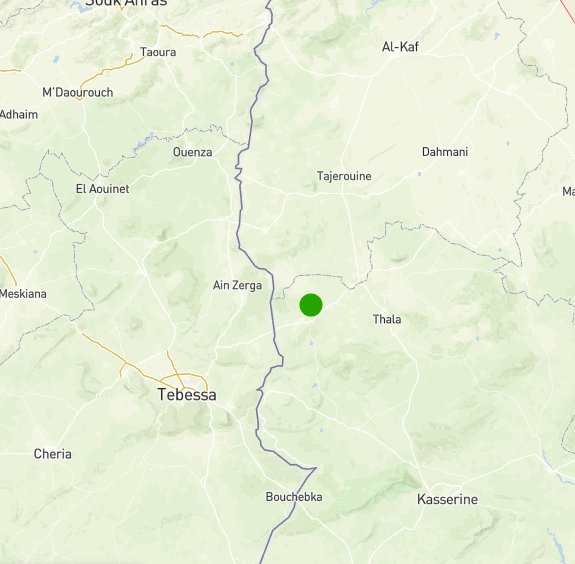
Map showing the desert zone where the people were forced to. Source: Alarm Phone
In the night 3 to 4 January, 613 people were expelled from Libya to the desert town Dirkou in Niger. This was the largest known deportation of people back to Niger to date.
On 5 January, several news reports as well as the Greek Coastguard reported that the merchant vessel NJ AIO rescued a group of 34 people from a boat in distress between East Libya and Crete. The group was then transferred by the coast guard to a reception centre on the island.

Map showing the position of the boat in distress. Source: Alarm Phone
On 6 January, the humanitarian ship Resq People rescued 47 people on two different boats.
On 9 January, 67 people from a wooden double decker boat in distress were safely embarked on the NGO ship Louise Michel.
On 10 January, 101 people were rescued by the civil vessel Ocean Viking from a double decker wooden boat, spotted by binoculars in the Libyan Search & Rescue Region.
On 20 January, the Libyan commander Njeem Osama Almasri, head of the Judicial Police in Tripoli, a key figure in the Mitiga prison and torture center, was arrested in Italy on a warrant from the International Criminal Court (ICC) for war crimes.
On 21 January, Almasri was released from prison and repatriated to Libya by order of the Italian Interior Minister Piantedosi, without prior notice or consultation with the ICC. The ICC recalled the duty of all state parties to cooperate fully with the Court in its investigations and prosecutions of crimes. Members of Refugees in Libya, victims of arbitrary detention in Libya, reacted as the Italian government came under fire for releasing the warlord: “Me, tortured by Almasri and his militiamen: I was beaten so badly that I thought I was going to die. President Meloni, how was it possible to accompany a bloodthirsty criminal and murderer back to Libya?” During the following weeks, there were several reports in the media and debates in the Italian Parliament about this affair.
On 22 January, Alarm Phone learned that four boats in distress that had alerted us were intercepted by the so-called Libyan Coastguard in international waters and forced back to detention and torture in Libya: One boat carried 58 people, the others had around 50, 45 and 90 people on board.
On the same day, the Court of Appeal in Valletta decided that Malta has jurisdiction over the case of the El Hiblu3. The cynical trial of the three young men who had prevented a pushback of more than 100 people to Libya thus continues at Malta’s criminal court.

Picture of the 3 accused people. Source: amnesty.org
Also on 22 January, it was reported that more than 600 people had arrived in the hotspot of Lampedusa. Most of the boats had departed from Zuwara, Libya, and were rescued by Italian authorities and Frontex.
On 24 January, media reported that the navy vessel Cassiopeia was ready to take people from detention centres in Italy on board to bring them to detention centres in Albania. The Cassiopeia headed to Albania with 49 people on board. Another 53 had presented passports to avoid transfers.
On 26 January, another shipwreck occurred about 53 nm off Lampedusa. The civil ship Sea Punk could rescue 15 people, recovered three bodies and reported three persons missing. Among the victims are two boys, aged two and three. Their parents are among the survivors.
On 27 January, Alarm Phone was alerted by a group of 25 people who had left Benghazi four days earlier. They reported a dramatic situation on board, including the death of two minors. A merchant vessel nearby had left the scene because RCC Malta had told them that they would take care of the situation. But only on 28 January we learned that the 23 people had been rescued by AFM and disembarked in Malta. The two bodies of the deceased had been brought to shore as well.

Map showing the position of the boat in distress. Source: Alarm Phone
On 28 January, about 61 people, including four children, in severe distress south of Crete alerted Alarm Phone. On the phone with the Greek Coastguard, the officers said that they were “investigating” the situation. Later, they told us that the group was rescued and on a patrol boat to Crete.
On 31 January, Italian judges did not validate the detentions in Albania, referring to the documents of the European Court of Justice. 43 persons had therefore to be released and brought back to Italy – now the third time this had happened.
February
In February, Alarm Phone was alerted to 51 boats in distress, among them 50 departing from Libya and one from Tunisia. NGO vessels rescued a total of seven boats that month – not all of them had alerted Alarm Phone. One boat was rescued by a merchant vessel on the way from East Libya to Crete and brought to Greece. The Italian Coastguard rescued at least eight boats. Often they rescued boats when they had almost reached Lampedusa, and they also coordinated some rescue operations of boats heading towards Sicily or Calabria. No boat was rescued to Malta. One boat was rescued by the Greek Coastguard. We know of 11 interceptions by the so-called Libyan Coastguard. About Tunisian interceptions we rarely receive reliable figures, we have details only about one case. We learned about one shipwreck in February.
On 2 February, the Italian Coastguard rescued 130 people in a stormy sea, 110 nm off Crotone. They were on board of a fishing boat that had left on January 30 from Turkey.
On 3 February, the Greek Ombudsman released their findings regarding the Pylos shipwreck in June 2023. They requested criminal prosecution for eight senior Greek Coastguard officers for felony charges. The Ombudsman examined around 5,000 pages of evidence and produced a 148-page report. It presents clear indications of criminal offences by these officers.
On 4 February, Alarm Phone alerted authorities to a group of 77 people fleeing from Libya. Their engine had stopped. A Frontex plane was observing them from the sky. Some hours later, the plane Seabird of the NGO Sea-Watch witnessed the interception of the boat. The people were forced back to Libya, although the merchant vessel MERNA had offered to assist.

Map showing the position of the boat in distress. Source: Alarm Phone
On 5 February, it was revealed that about 90 people, among them a well-known Italian migrant rescue activist and a member of Refugees in Libya, as well as journalists and human rights defenders in several countries, were targeted with spyware on their phones. Prime Minister Giorgia Meloni’s office said it asked the National Cybersecurity Agency to look into the affair, while denying any involvement. Alarm Phone expressed solidarity with the people attacked with spyware: “While Italy releases a Libyan warlord who has tortured migrants, those preventing death at sea are targeted!” Later it came out that also Don Mattia Ferrari, onboard chaplain of Mediterranea, was among the targeted individuals.
On 6 February, Alarm Phone learned from relatives that about 40 people who had alerted us in the Maltese Search and Rescue (SAR) zone had been unlawfully brought back to Libya. The same happened to 43 people in distress 32 nm south of Malta. They were intercepted by the so-called Libyan Coastguard and taken to a prison in Zuwara.

Map showing the position of the boat in distress. Source: Alarm Phone
On the same day, the global day of CommemorAction, people in many countries came together to denounce the murderous European border regime and to demand freedom of movement for all. Eleven years earlier, on 6 February 2014, more than 200 people had tried to cross the border from Morocco to Ceuta. At least 15 death bodies were found but many more remain missing.

Photo taken during a CommemorAction. Source: Alarm Phone
On 7 February, bodies of people on the move were recovered in two locations in Libya. Four days later, UNHCR published their concerns about these mass graves found in Libya’s desert.
On 10 February, it was reported that the Italian government wanted to modify the Albania decree. Accordingly, not only people rescued at sea but also those already in hotspots and reception centres on the national territory should be sent into Albanian detention.
On 13 February, about 20 people, who had alerted Alarm Phone from the Maltese SAR zone, were rescued by the Italian Coastguard – more than six hours after also Sea-Watch’s Seabird had informed authorities.
On the same day, the appeal of SOS Humanity against the detention of their ship Humanity 1 was rejected by the Court of Crotone. The judge claimed that the appeal against the detention was inadmissible and stated that the so-called Libyan Coast Guard’s interception of people fleeing from Libya was legitimate. However, this stands in stark contradiction to previous court decisions. SOS Humanity decided to appeal the decision and already filed an intervention at the constitutional court in Italy in October 2024.
On 16 February, two boats in distress south of Crete alerted Alarm Phone. The group of 64 people arrived safely on the island of Gavdos. The other group of about 40 people was brought to Crete by the Greek Coastguard.
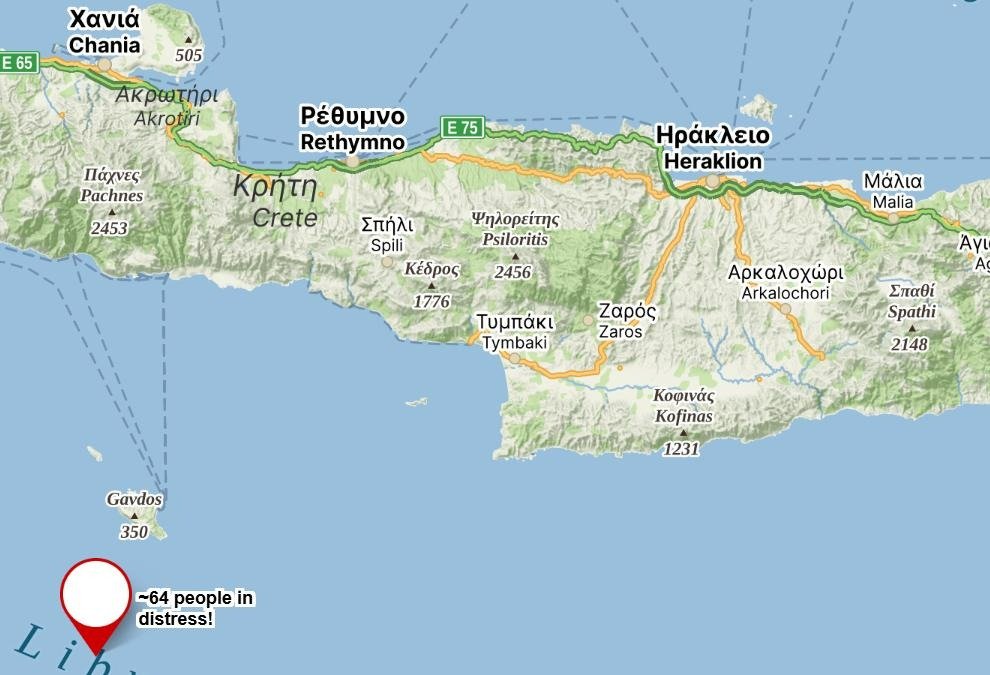
Map showing the position of the group of 64 people in distress. Source: Alarm Phone
On 18 February, the boat Nihayet Garganey VI, a common project of ArciNazionale and Sailingfor Blue LAB, rescued 55 people and brought them to Lampedusa.
On 18 and 19 February, the sailing boat Astral assisted two boats and had to wait 14 hours before the Italian Coastguard came to attend them.
On 19 February, 30 people in distress trying to escape from Libya to Sicily on a small boat alerted Alarm Phone. One day later we learned that this group was rescued by the Italian Coastguard.
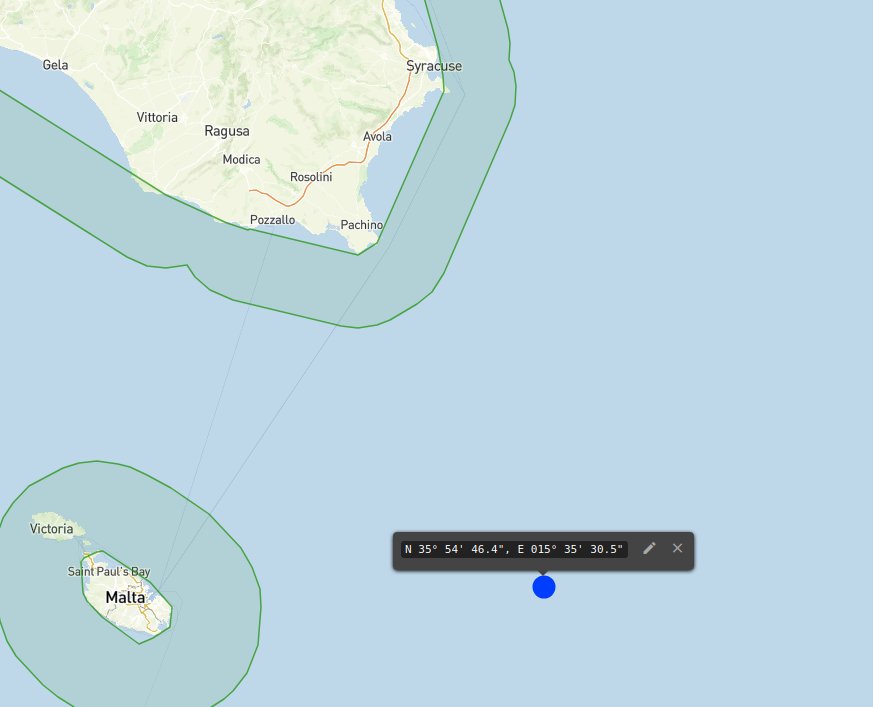
Map showing the position of the boat in distress. Source: Alarm Phone
On 20 February, the Humanity 1 crew rescued more than 40 people from an unseaworthy rubber boat. The Italian authorities assigned the port of Civitavecchia, 870 km away. Shortly before, the crew had spotted an empty boat, indicating an illegal pull-back by the so-called Libyan Coastguard.
On 21 February, a rescue of 35 people to Pozzallo, Sicily, was reported. We hope that these were the people who had alerted Alarm Phone, fleeing from Benghazi, Libya, five days before.
On 23 February, the civil rescue ship Sea-Eye 4 brought 41 people from an overcrowded boat safely onboard. Italy assigned them the port of Naples, three days of sailing away.
On the same day, the Ocean Viking performed two rescues in the Libyan SAR zone, one boat with 25, the other with 87 people on board.
On 25 February, 57 people on a rubber boat close to Lampedusa who had alerted Alarm Phone were rescued by the Italian Coastguard.
On 26 February, a rubber boat carrying around 75 people, who had alerted Alarm Phone as their engine stopped working, was illegally intercepted in the Maltese SAR zone and forced back to Libya.
On 28 February, Alarm Phone alerted authorities to a group of about 60 people adrift east of Kerkennah islands. They had departed from Libya and were in the Maltese rescue zone, but the Tunisian customs authority responded, stating they were returning the people to Tunisia, which is no safe place.
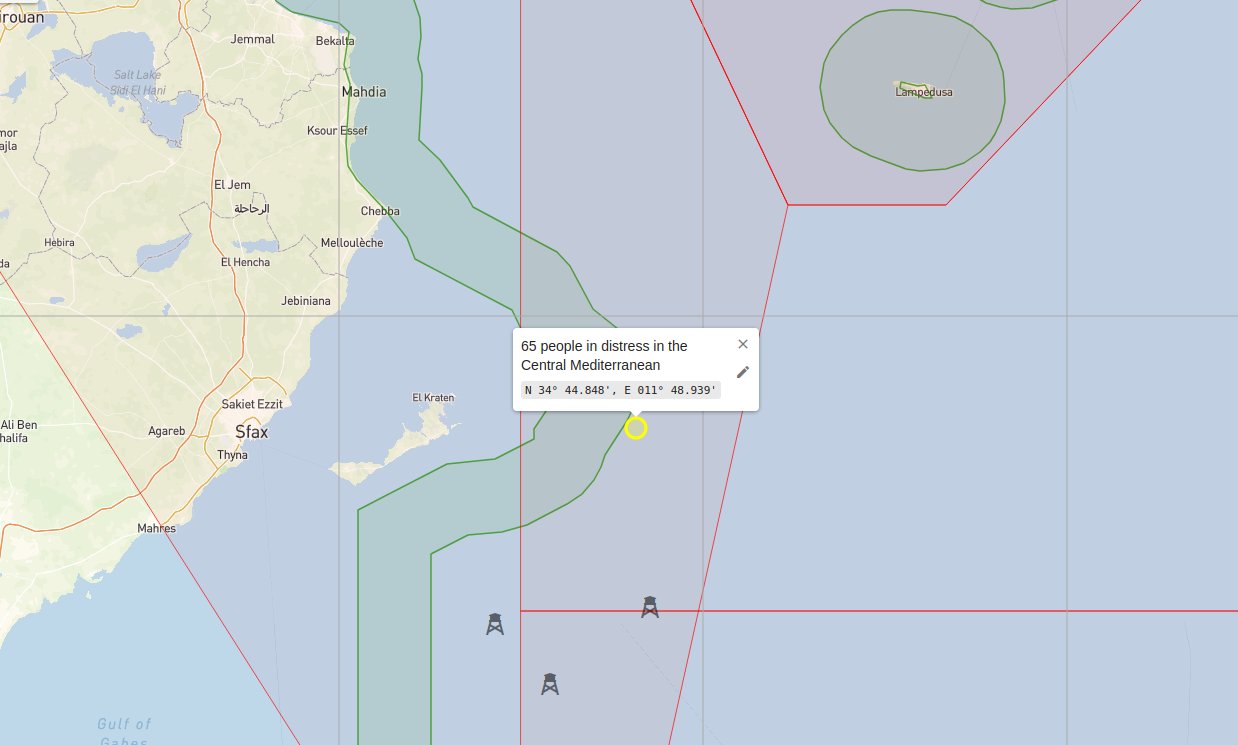
Map showing the position of the boat in distress. Source: Alarm Phone
March
In March, Alarm Phone was alerted to 42 boats in distress, among them 39 departing from Libya, two from Tunisia and one from Lebanon. NGO vessels rescued a total of 16 boats that month – not all of them had alerted Alarm Phone. Three boats were rescued by merchant vessels on the way from East Libya to Crete, one was brought to Crete, the others forced back to Egypt and Libya. The Italian Coastguard rescued at least eight boats. Often they rescued boats when they had almost reached Lampedusa, and they also coordinated some rescue operations of boats heading towards Sicily or Calabria. No boat was rescued to Malta. Two boats were rescued by the Greek Coastguard. We know of 15 interceptions by the so-called Libyan Coastguard and one by the Egyptian Coastguard. About Tunisian interceptions we rarely receive reliable figures, we have details only about one case. We learned about two shipwrecks in March.
On 2 March, Alarm Phone was alerted to 32 people fleeing from Libya, stranded on the Miskar gas platform. They said that one person had drowned and the others were in bad health conditions. They were in international waters in the shared Tunisian / Maltese SAR region. In a joint statement, several Tunisian organisations demanded that the people must not be pushed back to Libya or Tunisia. but rescued to a safe place. Following an urgent request by SOS Humanity, UpRights, Stra_Li and the support of Alarm Phone, the United Nations Human Rights Committee instructed Malta on 4 March 2025 to urgently coordinate a search and rescue operation for the 32 individuals who had been in distress for four days near and on the Miskar gas platform. Malta was also ordered to ensure their disembarkation in a place of safety. In the end, Sea-Watch confirmed that their vessel Aurora rescued the people and brought them to Lampedusa.
On 5 March, in Crotone, Italy, the preliminary hearing began in the case of the Cutro shipwreck, which had occurred on 26 February 2023 and claimed the lives of 94 people, including 35 children.
On 7 March, the Diciotti case was reopened. The Court of Cassation, the highest level of the Italian justice system, upheld the appeal of an Eritrean migrant who had been on board the coastguard ship which had rescued the people. On the orders of the Minister of the Interior, Matteo Salvini, this ship was not allowed to dock in an Italian port from 16 August to 25 August 2018, and in the following six days, once allowed to dock in Catania, did not obtain consent to disembark on land. According to the Court of Cassation, they should have disembarked immediately and therefore the damage to the migrants had to be compensated.
On 8 March, the Marine Detachment of Tariq Ben Zeyad Brigade interdicted off the coast of Bomba, East Libya, a boat with 70 people who had attempted to reach Greece. The same happened on 9 March to a boat carrying 120 people off the coast of Tobruk.
On 9 March, a relative alerted Alarm Phone about a group of 64 people south of Crete. JRCC Piraeus informed us that they had located the boat and that they would launch a rescue operation. According to the Greek Coastguard, all of them were rescued and brought to the island of Gavdos.
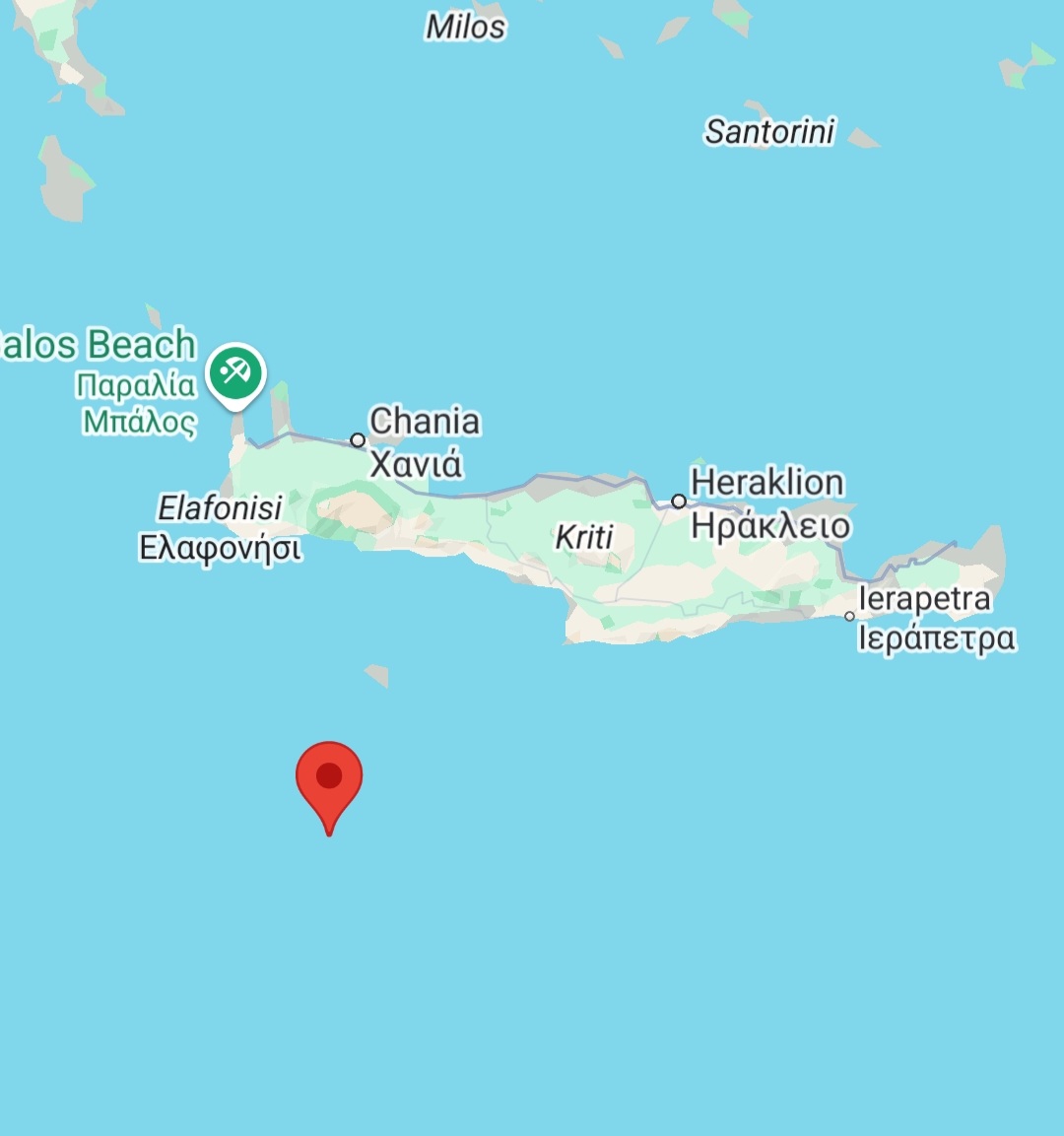
Map showing the position of the boat in distress. Source: Alarm Phone
On 10 March, the Ocean Viking rescued 25 people from distress following an alert from Alarm Phone.
On 11 March, the Civil Court of Salerno confirmed the suspension of the 60-day administrative detention imposed on 26 August 2024 on the Geo Barents, the search and rescue vessel operated by Médecins Sans Frontières (MSF).
On 12 March, Alarm Phone was alerted to a boat in distress between East Libya and Crete, carrying 42 people. The merchant vessel ECTOR rescued them but brought them to Port Said, disregarding the grave concerns about the safety of disembarking people in Egypt.

Track of the merchant vessel ECTOR on VesselFinder.com. Source: Alarm Phone
On 13 March, the civil sailing ship Nadir found an overcrowded rubber boat with 40 people on board at night. The crew accompanied them and requested immediate evacuation for one unconscious person. In the morning, the Italian Coastguard evacuated everyone.
On 14 March, we received reports about mass arrests of people on the move in Tripoli and other parts of Libya. Thousands were detained and many have been killed or wounded in the operations. Security forces and militias backed by Libya’s Interior Ministry were violently raiding homes and shelters, specifically targeting Sudanese and Sub-Saharan African communities. A witness said: “The police don’t look at the documents, but many are refugees registered with the UNHCR“.
On 15 March, Alarm Phone was in contact with a boat between Libya and Crete, carrying 33 people. After we alerted authorities, the merchant vessel YM WISDOM altered course and rescued the people, but brought them back to Libya to violence and cruel exploitation.

Track of the merchant vessel YM WISDOM on VesselFinder.com. Source: Alarm Phone
On 16 March, we learned that another boat adrift between Libya and Crete was also rescued by a merchant vessel and brought to Palaiochora, Crete.
On 17 March, Tunisia’s National Guard reported 612 people “rescued” in the night before without revealing their fate.18 bodies had been recovered. For the first time since June 2024, Tunisian authorities have released numbers but countless shipwrecks and missing people remain unreported.
On 18 March, the Nadir reported that some days earlier, they had found a rubber boat near an oil platform off Libya. The boat was flooded with sea water and fuel. Around 25 people were in the water. The crew recovered people from the water and the shipwreck. Yet, at least one person reportedly remained missing. Instead of the closest port Lampedusa, where the survivors were disembarked,
On 19 March, a shipwreck near Lampedusa was reported: six people drowned, 40 went missing. Survivors said that some of the missing had fallen off the boat in a rough sea.
On 20 March, Refugees in Libya published a press release about the drastic outbreak of violence against Black people in Libya.
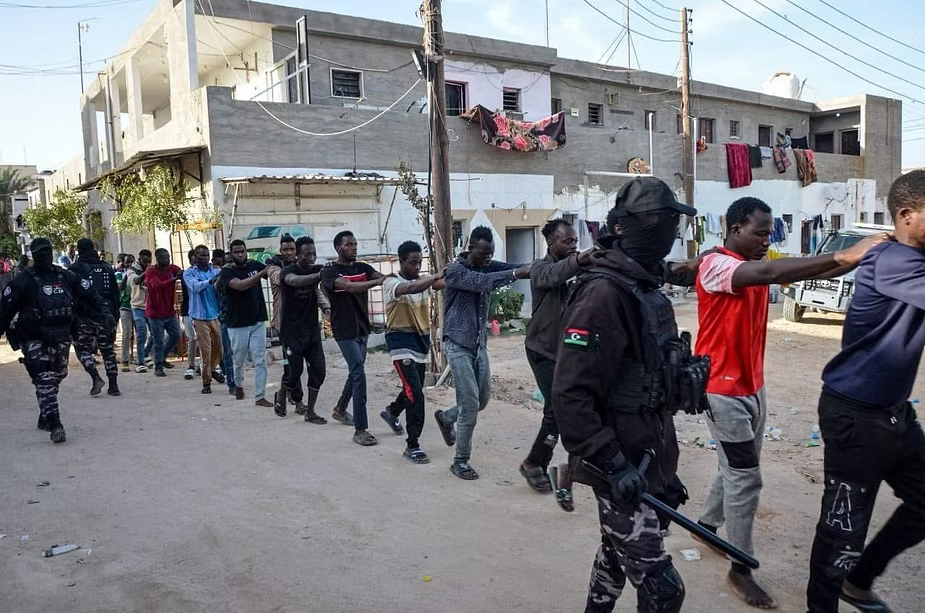
Photo of arrested people in Libya. Source: Refugees in Libya
On the same day, it was revealed that, according to documents circulating on social media, Tunisia has decided to withdraw its recognition of the jurisdiction of the African Court on Human and Peoples’ Rights. The written statement signed by the Minister of Foreign Affairs and Tunisians Abroad, Mohamed Ali Nafti, dated 3 March 2025, was forwarded on 7 March by the Permanent Mission to the African Union to the Office of the AU Chairperson, requesting him to immediately implement the legal consequences of the withdrawal.
On 22 March, another Libyan torturer was quietly visiting Italy. His name is Abdul Ghani Al-Kikli, known as Gheniwa, and together with other Libyan government officials, he visited the Libyan Minister of the Interior, hospitalized in Rome after being injured in an attack. The militia he leads is called the Stability Support Apparatus (SSA). In violent manoeuvres, they pull back people trying to reach Europe. SSA is also known for having repeatedly shot at NGO ships.
On 24 March, documents exposed Malta’s continued refusal to conduct rescue missions in its search and rescue zone. “Between January and October 2024, Malta rescued 92 people, and the Italian coastguard rescued 12,399. The Libyan coastguard intercepted 8,179, and NGO vessels saved 8,271. These numbers expose a deliberate strategy: if Malta does not respond, the problem becomes someone else’s burden. What is equally disturbing is the lack of official response. NGOs repeatedly report that the Maltese authorities do not answer distress calls or emails.”
On 25 March, it was published that Italy plans to reopen the repatriation hubs in Albania. Interior Minister Matteo Piantedosi confirmed part of the plan in an interview with La Stampa: “The Albanian centers could help strengthen the repatriation system for irregular migrants who have no right to remain in Italy.” The Italian government issued a decree on 28 March allowing the facilities to hold undocumented migrants, currently in Italy, who have been ordered detained pending deportation. Some days later, the spokesperson of the EU Commission, Markus Lammer, said that the new decree would be in line with European law.
On 27 March, the Guardian reported that the Italian government had approved the use of a sophisticated surveillance tool (Paragon) to spy on members of a humanitarian NGO because they were allegedly deemed a possible threat to national security. The intelligence agencies had used the surveillance system within the parameters of the law in order to conduct a “preventive” investigation into illegal immigration. Activists commented: “This is not simply an activity against us, but an activity against the International Criminal Court, with which we have been collaborating for a long time. The only explanation for the use of such invasive software is to acquire material without leaving a trace”.
On 28 March it was the sixth anniversary of the criminalisation of the El Hiblu 3 – criminalised in Malta, simply for wanting freedom and safety, for showing solidarity with others.
On 31 March, Alarm Phone alerted authorities to 34 people in distress who had departed from Tunisia on an iron boat. Tunisian authorities said they could not find them. Seabird searched for them the whole day in two-meter-high waves, but in vain. Only on 3 April we learned that probably one of the two boats rescued by the Humanity 1 was the one that we had been in touch with.
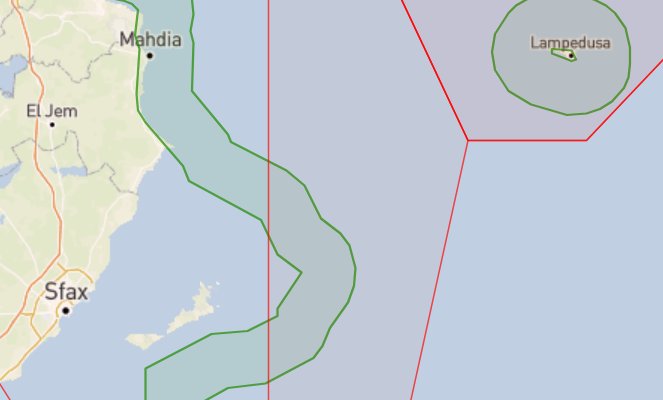
Map showing the route between Sfax/Tunisia and Lampedusa. Source: Alarm Phone
April
In April, Alarm Phone was alerted to 53 boats in distress, among them 48 departing from Libya, five from Tunisia. NGO vessels rescued a total of 16 boats that month – not all of them had alerted Alarm Phone. One boat was rescued by a merchant vessel on the way from East Libya to Crete and brought to Greece by a Frontex boat. One boat was rescued by fishermen. The Italian Coastguard rescued at least four boats. Often they rescued boats when they had almost reached Lampedusa, and they also coordinated some rescue operations of boats heading towards Sicily or Calabria. No boat was rescued to Malta. One boat was rescued by the Greek Coastguard. We know of 14 interceptions by the so-called Libyan Coastguard. About Tunisian interceptions we rarely receive reliable figures, we have details only about one case. We learned about three shipwrecks in April, one of them was an Alarm Phone case.
On 2 April, Refugees in Libya were informed that massive raids in Tunisia were planned. The Tunisian National Guard and police had mobilised more than 1,000 officers and several busses and trucks with machines to destroy the camps north of Sfax and push the people on the move away from the coast.
On the same day, in Libya, ten humanitarian NGOs supporting people on the move were suspended and their offices closed. The charges range from “fostering demographic change” to the alleged “encouragement of values contrary to Libyan identity, such as Christianity, atheism, promotion of homosexuality and moral decadence.”
On 3 April, Alarm Phone was in contact with about 80 people on board a rubber boat who said they were capsizing in rough weather and sea conditions. After alerting authorities, we were informed that this group was intercepted and returned to Libya, where they were imprisoned.
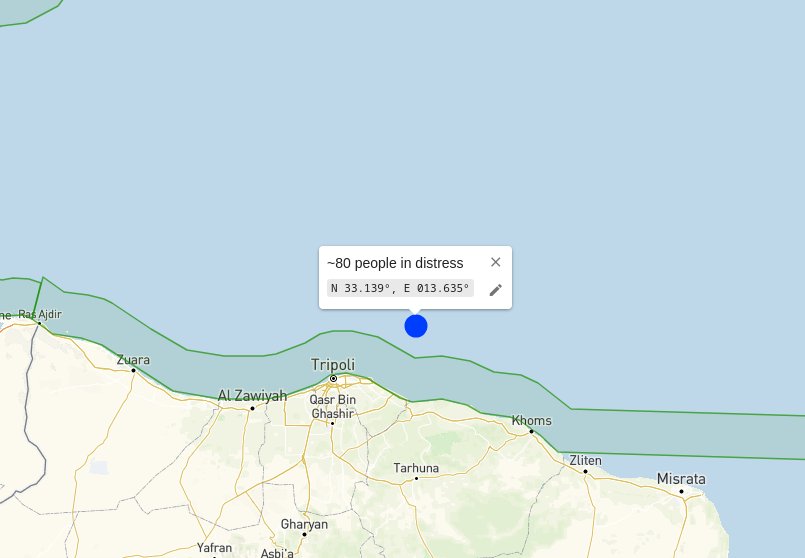
Map showing the position of the capsizing boat. Source: Alarm Phone
On 4 April, 68 people who had called Alarm Phone in urgent distress of Abu Kammash, Libya, were also intercepted by the so-called Libyan Coastguard.
On 6 April, we feared another Libyan interception of a boat carrying 33 people who had called us the day before in distress south of Crete. We learned that the Libyan Coast Security vessel “TBZ 3” intercepted north of Tobruk 59 people who tried to reach Greece.
On 5 April, a shipwreck happened north of Tripoli. That evening 37 people had departed but shipwrecked the same night. Only three people survived. Alarm Phone was never in direct contact with the boat but continuously received requests from relatives searching for their missing loved ones.
On 7 April, it was reported that more than 1,600 people had landed in Lampedusa since 5 April.
On 8 April, hundreds of people who were violently driven away from the makeshift camps north of Sfax stranded in front of the IOM office in Tunis. Over 30,000 people – mostly from Sudan, Mali, Gambia, Guinea, Ivory Coast, and other war-torn or poverty-stricken countries – had been living there, some for more than a year.
On 10 April, the ship LIBRA departed from Brindisi to bring 40 people from Italian deportation centres to the camp in Shengjin, Albania. The transfer had to be postponed by 24 hours as in the port of Brindisi a sit-in protest by associations against this transfer took place. The United Nations High Commissioner for Refugees said some days later about such outsourcing: “We are always open to discussing these solutions. The so-called Rwanda model which the United Kingdom considered for some time, was unacceptable because it was a transfer of responsibility that denied all rights. Then there are models like that of Italy in Albania, which is certainly more interesting. We were offered a role of monitoring and judging and we said we were available.”
On 13 April, Alarm Phone was alerted by a group of 67 people who had fled from Libya, drifting east of Tunisia in very bad weather. After hours of non-assistance by authorities, the civil fleet ship Aurora rescued the people and brought them to Lampedusa.

Map showing strong wind on the route from Libya to Lampedusa. Source: windy.com
On 14 April, after meeting with the Interior Ministers of Italy, Tunisia and Algeria, Libya’s minister Trabelsi proudly announced: „We finally approved a plan to return all migrants in Libya through a voluntary return program“. In Tunisia, the violent eviction of the camps in the olive groves went on.
On 15 April, we learned that a boat carrying 37 people who had alerted Alarm Phone in distress south of Sicily was rescued by the Italian Coastguard.
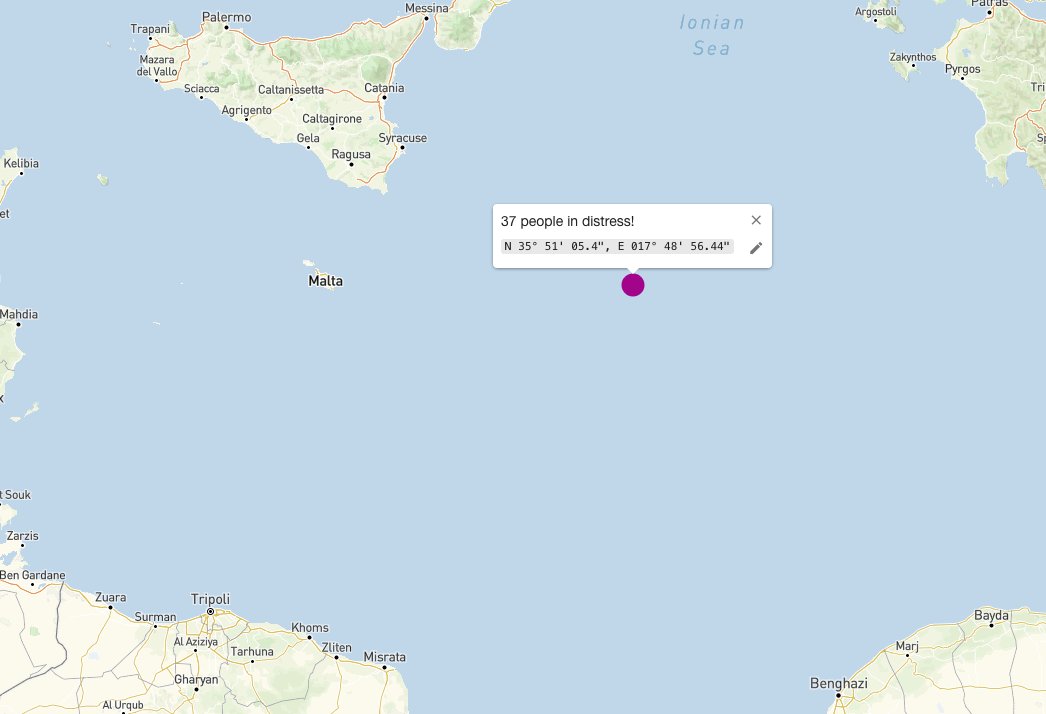
Map showing the position of the boat in distress. Source: Alarm Phone
On 18 April, we commemorated the largest shipwreck in recent Mediterranean history ten years earlier and called for open borders to end deaths at sea.
On the same day, a group of 42 people who had alerted Alarm Phone on the way from Libya to Crete, was rescued by a merchant vessel south of Gavdos according to a media report and transferred to a Frontex ship that transported them to Crete.
On 19 April, the first person was repatriated from the deportation camp in Albania. Three people were brought back to Italy for having committed self-harm, one person because he applied for asylum, 35 people remained there.
On 21 April, Alarm Phone alerted authorities at night about a group of 90 people in distress, slowly moving against an upcoming storm. Only after more than 20 emails and 24 hours after our initial alert, an Italian Coastguard ship took the people onboard. We thanked the crew of two merchant vessels, OSLO CARRIER and AEGEAS, for providing shelter to prevent the boat from capsizing.

Map showing the position of the boat in distress. Source: Alarm Phone
On 23 April, the Nadir rescued 92 people from two boats in distress. One of them was reported missing for four days. 87 people were picked up by an Italian Coastguard vessel on the way. All survivors were brought to Lampedusa.
On the same day,137 refugees and protection seekers were evacuated from Libya to Rwanda under the Emergency Transit Mechanism. According to UNHCR, a total of 2,760 people had been evacuated from Libya to Rwanda since 2019, with over 2,100 already resettled in third countries.
On 24 April, Alarm Phone alerted authorities about 75 people adrift off Libya. Eventually, after several hours, the so-called Libyan Coastguard intercepted the boat.
On 25 April, powerful protests took place in Tunisia demanding freedom for Professor Ahmed Sawab and all political and civil society activists imprisoned.

Photo of the demonstration in Tunis. Source: @brirmijihed.bsky.social
On 26 and 27 April, two more pushbacks by the Libyan Marine Detachment of Tariq Ben Zeyad Brigade took place: one of 82 people off Tobruk, the other one of about 60 people off Al Tamimi.
On 28 April, we learned about a shipwreck off Tunisia and another one off Lampedusa. 13 people died.
On 29 April, we were relieved that – according to a relative – the people of a boat, carrying 46 people, who had alerted Alarm Phone the day before and reported that their engine had exploded, were rescued to Lampedusa.
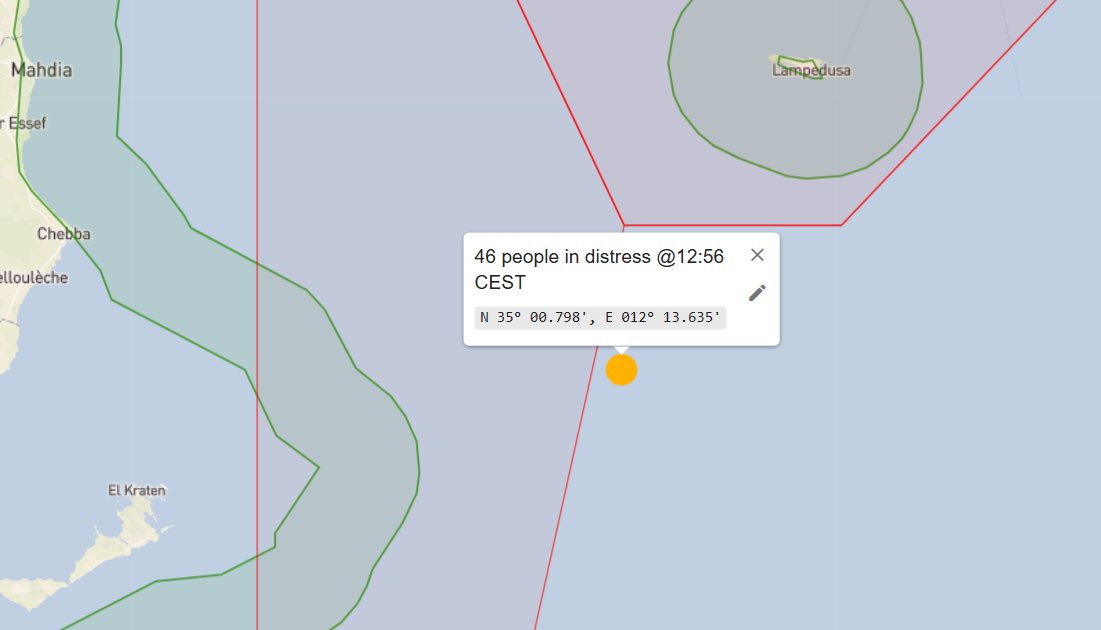
Map showing the position of the boat in distress. Source: Alarm Phone
On 30 April, media reported that of the 41 people brought to the Albania camp, only 25 remained there. In the other cases, the individuals were deemed unfit for detention in Albania, mainly for health reasons. The Rome Court of Appeal – the body responsible for reviewing and authorising or extending the detention of asylum seekers – also ruled against the detention of six of the 41 migrants transferred to Albania. The court found that their detention was unlawful and contrary to asylum law, as well as to the Italy-Albania agreement.
May
In May, Alarm Phone was alerted to 77 boats in distress, among them 62 departing from Libya, 13 from Tunisia, one from Algeria and one from Lebanon. NGO vessels rescued a total of 27 boats that month – not all of them had alerted Alarm Phone. Two boats were rescued by merchant vessels, one of them brought to Italy, another one forced back to Libya. The Italian Coastguard rescued at least 16 boats. Often they rescued boats when they had almost reached Lampedusa, and they also coordinated some rescue operations of boats heading towards Sicily or Calabria. No boat was rescued to Malta. Two boats were rescued by the Greek Coastguard. Two boats arrived by themselves in Greece, one autonomously in Lampedusa. We know of 14 interceptions by the so-called Libyan Coastguard. About Tunisian interceptions we rarely receive reliable figures, we have details only about five cases. We learned about two shipwrecks in May, one of them an Alarm Phone case.
On 2 May, the Freedom Flotilla ship CONSCIENCE, carrying food and medicine for the starving Gaza population, came under direct attack by a drone in international waters off Malta. It was burning and 30 international activists on board were in urgent distress. Malta did not help, but denied entry to the ship.
On the same day, 15 people from detention centres in Italy were transferred to Albania to the centre of Gjader. This happened without official communications.
On 4 May, about 100 people who had tried to escape the brutal conditions in Tunisia were intercepted by the Tunisian Coastguard, arrested and deported to the Algerian desert. They had alerted Alarm Phone but most phones had been confiscated so that we could not reach them anymore.
On the same day, 32 people in severe distress east of Malta alerted Alarm Phone. Once again, the Maltese authorities failed to coordinate rescue in their SAR zone. One day later, we learned that at night the people were finally rescued by the Italian Coastguard.
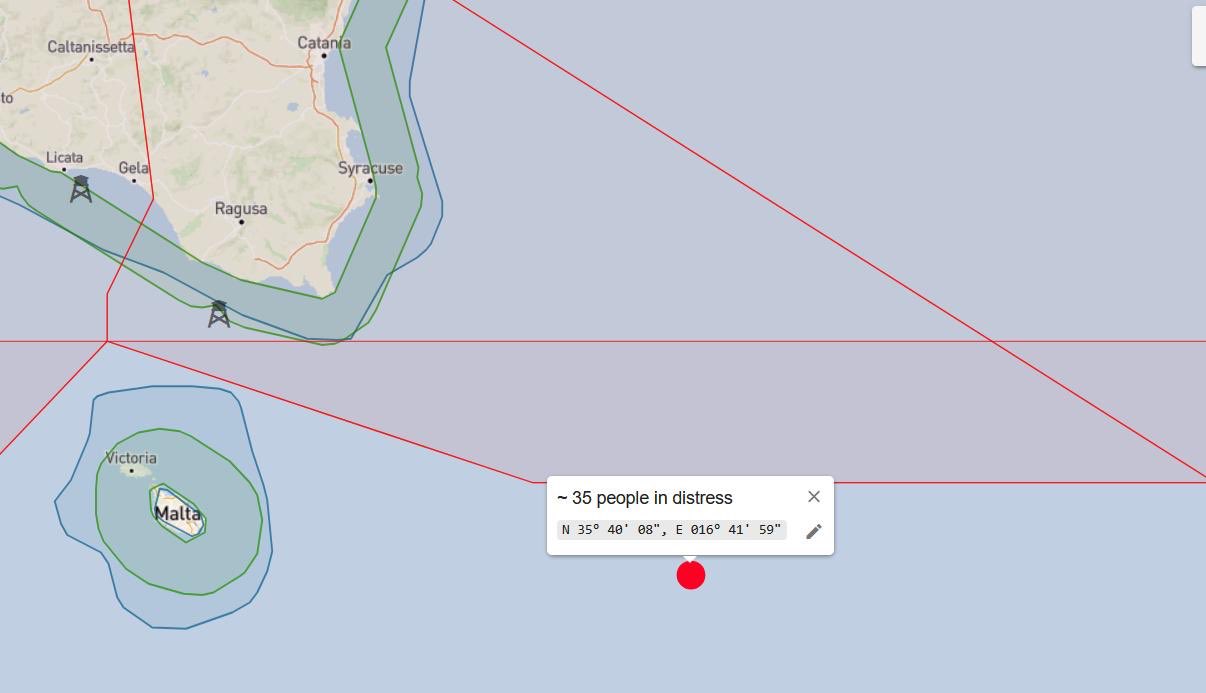
Map showing the position of the boat in distress. Source: Alarm Phone
On 5 May, we learned that a boat carrying about 50 people who had left Libya on 26 April and had alerted Alarm Phone, had capsized. According to survivors, a fire broke out, forcing the people to jump into the sea. Fishermen rescued two persons (the only survivors) and brought them to Tunisia.
On 7 May, the Trump administration announced plans to send migrants to Libya from the US. On the next day, the Libyan Prime Minister Dbeibah rejected such deportations and accused “illegitimate entities that do not represent the Libyan state” – referring to the parallel government led by Osama Hamad and Khalifa Haftar – of being behind the alleged agreement.
On 8 May, a Frontex ship rescued 65 people who had alerted Alarm Phone south of Gavdos. Two days later, Frontex also found and rescued 82 people 15 nautical miles south of Gavdos. Probably it was also a boat that had alerted Alarm Phone on the route from Libya to Crete.
On 9 May, Alarm Phone published a solidarity statement with the Gaza Freedom Flotilla, signed by 64 organisations and several individuals.
On 10 May, the crew of the Humanity 1 reported that they had rescued 125 people in a difficult operation on the evening before. The people had alerted Alarm Phone. Italian authorities assigned the Humanity 1 the over 1,500 km away distant port of Ravenna.
On 10 and 11 May, the NADIR crew assisted 62 people on a drifting rubber boat south of Lampedusa following a Mayday Relay issued by the Frontex airplane EAGLE2. Two toddlers had already died on the boat. Another person was declared dead on NADIR despite all resuscitation efforts. Underway, an Italian Coast Guard vessel came to evacuate four survivors in critical conditions onto their ship. The NADIR, with many survivors with severe chemical burns, went to disembark in Lampedusa.
On 12 May, people in the olive groves in Tunisia were protesting against cruel and brutal treatment. Over 400 women with their children and about 100 men marched in El-Amra near Sfax after their makeshift camps had been destroyed.
On 13 May and the following days, violent clashes during protests of Libyan citizens against the Dabeiba government in Tripoli occurred. The situation was deadly for Libyans but even more severe for people on the move. They could not even go out to fetch water or food, others were locked in detention camps, subjected to torture and rape. After the clashes, Black people were forced to go out and sweep the rubble, the remains of skulls, and scattered corpses.
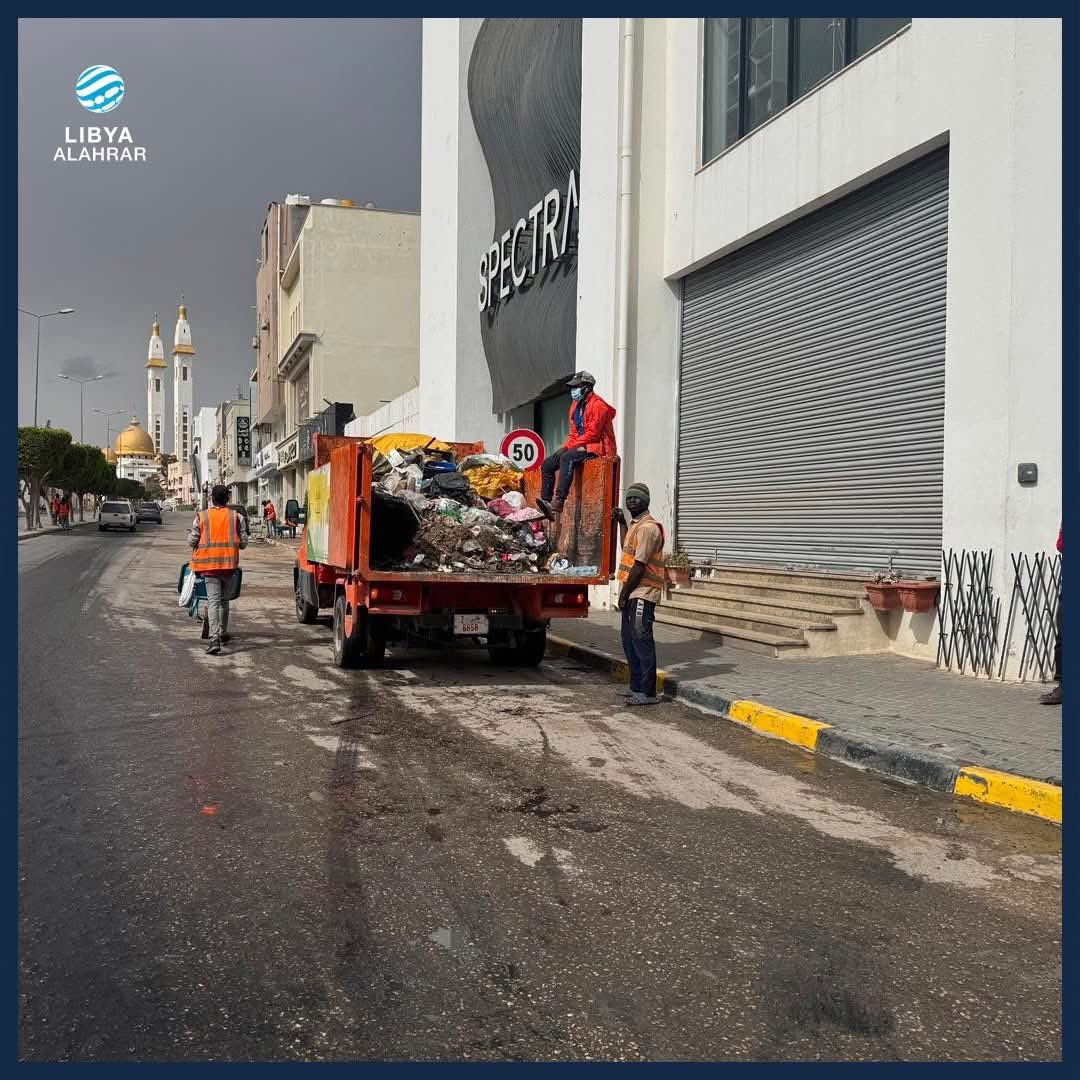
Photo showing Black people in Libya cleaning the streets. Source: Refugees in Libya
On 17 May, media reported that Libyan ministers had resigned as protesters had called for government to step down. A police officer was killed as the country saw renewed deadly clashes in the aftermath of the killing of a militia commander. In the city of Misrata, protesters gathered in support of Dabeiba and his government.
On the same day, the Ocean Viking received an alert from Alarm Phone about 77 people in distress, whom the Aurora already assisted. The people were rescued and later also 131 people from an overcrowded wooden boat, spotted in Maltese SAR.
On 18 May, Alarm Phone was alerted to about 70 people who said they were shot at in Libyan SAR. They were still moving, but the boat was damaged and water was coming in. They were close to Italian SAR and according to a relative rescued by the Italian Coastguard and brought to Lampedusa.

Map showing the position of the boat in distress. Source: Alarm Phone
On 20 May, Frontex announced that for the first time, their surveillance aircraft had flown directly from a country outside the EU. “The milestone flight from Tirana International Airport in Albania signals a new chapter in how we manage borders that means an earlier detection of irregular migration.”
On 21 May, 32 people who had escaped from Benghazi called Alarm Phone for help when they had been already three days at sea. We alerted Italian authorities and they rescued them to Calabria.

Map showing the position of the boat in distress. Source: Alarm Phone
On 21 and 22 May, three boats on the way from East Libya to Greece were intercepted by the Marine Detachment of Tariq Ben Zeyad Brigade. The first boat had 40, the second and third each 43 people on board.
On 24 May, 418 people arrived in southern Crete. Some of these boats had alerted Alarm Phone, one carrying about 70 people, another boat 53 people, and a third one 47. We lost contact, but we learned from relatives and media that these boats were rescued by the Greek Coastguard.
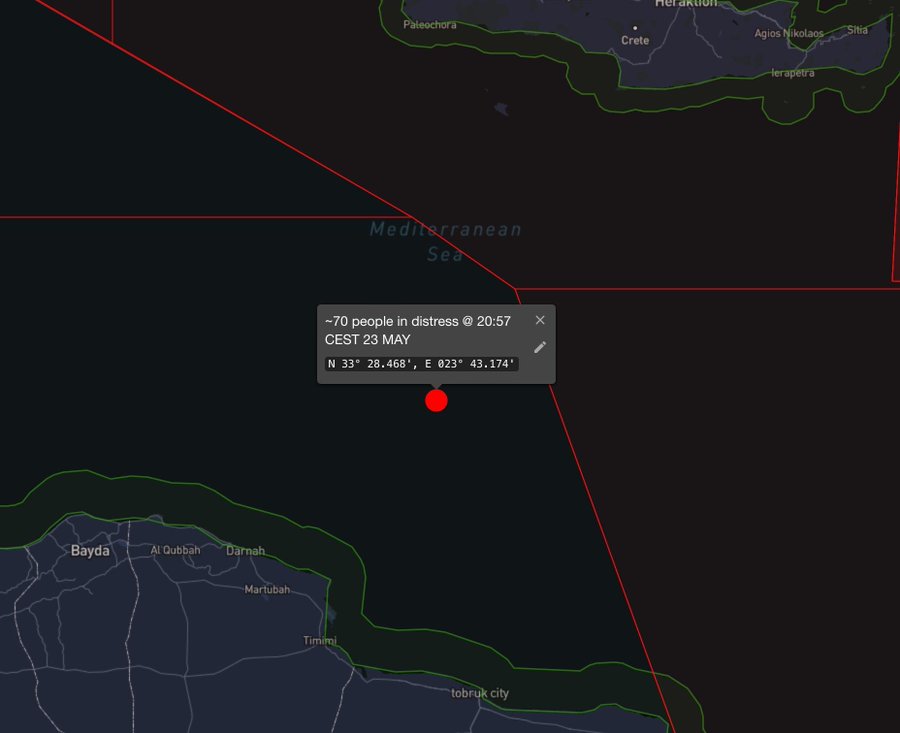
Map showing the position of the boat carrying 70 people. Source: Alarm Phone
On 25 May, we learned that one of two boats, carrying about 200 people, who had alerted us the day before, was rescued by the Italian Coastguard to Lampedusa. 35 of the people on the other boat were rescued by the merchant vessel BOBIC. The captain urgently asked for support by coastguards – in vain. 75 people remained on the boat, drifting away from the merchant vessel. In the following night, a supply vessel, the ECO ONE, rescued 26 of these people, but could not recover all due to again worsening sea conditions. The Ocean Viking arrived shortly after and evacuated the 53 remaining people. Survivors told that at least three people had fallen overboard and could not be found.
On 26 May, we learned that the 35 people on the MV BOBIC were forced back to Libya and were imprisoned in Zawiyah. The Italian journalist Scandura published a summary of the “weekend of fear and chaos” and a map, showing all assets involved in this case.
On 27 May, we published together with SOS MED a press release on this case, a deadly failure of duty by European coastguards. Some weeks later, a detailed report was sent to several organisations, state actors, and Members of EU Parliament, demanding an investigation of this case.

Map showing the positions of the two boats in distress. Source: Alarm Phone
On 28 May, ongoing peaceful protests of refugees in the olive groves near Sfax/Tunisia were reported. Women, children and weak people were demanding protection and all of them respect for their rights and dignity.
On the same day, 500 displaced Sudanese people were returned from Kufra, Libya, to Sudan in the first truck convoy organised by local authorities.
On 29 May, the Court of Ragusa decided to indict six activists of Mediterranea Saving Humans on charges of ‘aggravated aiding and abetting illegal immigration.’ The decision refers to what happened on 11 September 2020, when the ship Mare Jonio intervened to rescue 27 migrants who had been on board the Danish tanker Maersk Etienne for 38 days, abandoned in the middle of the sea without any possibility of disembarkation, despite their serious physical and psychological conditions. Mediterranea decided to bring those people to safety in the port of Pozzallo, where they disembarked with the authorisation of the Italian authorities. Mediterranea reacted to this attempt to criminalise solidarity with the announcement of a new ship: The Sea-Eye 4 becomes MEDITERRANEAN and continues its mission as a ship of care, solidarity and dignity.
On 30 May, the Italian Court of Cassation referred two cases of detention in the camps in Albania to the European Court of Justice.
On 31 May, it was announced that on June 9, the Italian Constitutional Court would decide on the legitimacy of the Italian and Albanian detention centres.
June
In June, Alarm Phone was alerted to 66 boats in distress, among them 56 departing from Libya, eight from Tunisia, for two others we do not know the departure place. NGO vessels rescued a total of 16 boats that month – not all of them had alerted Alarm Phone. One boat was rescued and two boats were assisted by merchant vessels and later brought by the Italian Coastguard to Sicily. The Italian Coastguard rescued at least twelve boats. Often they rescued boats when they had almost reached Lampedusa, and they also coordinated some rescue operations of boats heading towards Sicily or Calabria. One boat was rescued to Malta. Of one boat we know that it was rescued by the Greek Coastguard, but there were probably more. One boat arrived autonomously in Lampedusa, another one on the Greek island of Gavdos. We know of 21 interceptions by the so-called Libyan Coastguard. About Tunisian interceptions we rarely receive reliable figures, we have details only about five cases. We learned about three shipwrecks in June.
On 1 June, the Louise Michel crew spotted a fibreglass boat. On approach, people suddenly started jumping into the sea. The crew was able to rescue all 14 people from the water.
On 2 June, media reported that Greece was seeking a migration agreement with Libya to reduce the number of departures from the Eastern Libyan coast.
On 3 June, the Italian Court of Justice ruled in the case C-460/23 Kinsa, which raised a key question: May a parent who enters the EU in an unauthorised manner be accused of facilitating illegal immigration simply because they are accompanied by their minor children? The Court decided in favour of the woman who had entered the EU with her daughter and niece, both minors, who needed her protection.
On 4 June, three boats, carrying a total of about 200 people, alerted Alarm Phone. They had departed from Tobruk towards Crete. While the Greek coastguard simply hung up on us, none of the numbers of the so-called Libyan coastguard was responsive. We fear that the people were returned to Libya.
On 5 June, the Gaza Freedom Flotilla responded to a distress case. The Madleen activist vessel on its way to Gaza rescued four people who had jumped from a boat in distress when a vessel of the Libyan militia Tariq Ben Zeyad, informed by a Frontex plane, had intercepted the boat.
On the same day, 37 people in distress south of Sicily who had alerted Alarm Phone were sheltered by the merchant vessel SVENDBORG until the Italian Coastguard came and rescued the group.
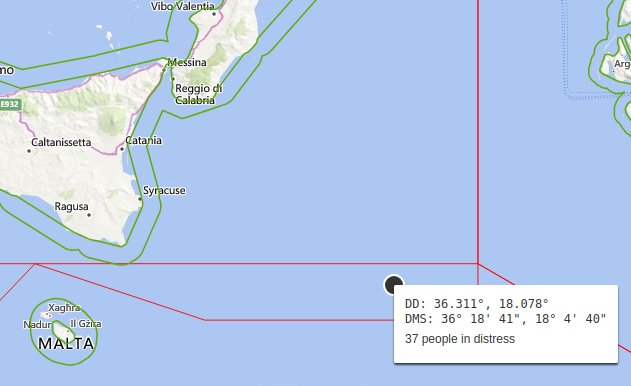
Map showing the position of the boat in distress. Source: Alarm Phone
On 6 June, Alarm Phone alerted authorities to about 62 people on their way to Crete. The Greek coastguard told us that the case was in the area of responsibility of the so-called Libyan coastguard. One day later we learned that a group of 64 people had arrived by themselves on the island of Gavdos, south of Crete. We believe it matches this group.
On 7 June, about 200 people fleeing Libya on a fishing boat alerted Alarm Phone. The merchant vessel LADY ZEHRA diverted course and rescued the group. Later the Italian coastguard came and brought them to Sicily.
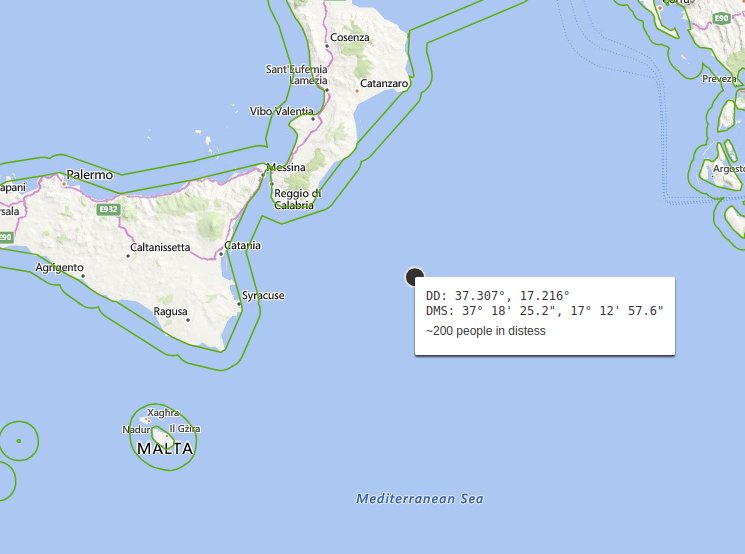
Map showing the position of the boat in distress. Source: Alarm Phone
On 8 June, a women gave birth on an oil platform off the coast of Libya. She had stranded there with 53 others who had escaped a shipwreck. Eventually they were rescued by the sailing ship Astral of Open Arms, following an alert from Alarm Phone, and were taken to Lampedusa.
On 9 June, the NGO Resqship announced that their sailing boat Nadir was arbitrarily detained by the Italian authorities after rescuing 112 people from distress at sea. They were accused to have failed to contact Libyan and Tunisian authorities and ignored instructions regarding a designated Port of Safety. In fact, they contacted all authorities, but only Italy responded and instructed them to bring the rescued people to Lampedusa, what the Nadir crew did. Alarm Phone and other SAR organisations condemned this detention and expressed their solidarity.
On 11 June, dozens of bodies had been found on Mahdia and Sfax beaches in Tunisia according to the Tunisian Forum of Economic and Social Rights (FTDES).
On 12 June, a ruling of the European Court of Human Rights (ECHR) legitimised the Italian strategy of pushbacks and violence by the so-called Libyan coastguard, acting on a mandate from Italy and with resources donated by Italy.
On 13 June, a delegation of Italy’s ruling Brothers of Italy visited Lampedusa. They met with the mayor to discuss boat arrivals and the hotspot of the island, through which over 140,000 people had passed in the last two years.
On 12 and 13 June, two deadly shipwrecks happened. On 12 June, 21 people were reported missing after a shipwreck near Alshab port in Tripolitania, where only five survivors were found. This boat had alerted Alarm Phone. The second tragedy occurred on 13 June, approximately 35 kilometres west of Tobruk. According to the sole survivor, who was rescued by fishermen, 39 people were lost at sea. In the days that followed, three bodies were washed ashore: two on Umm Aqiqih beach on 14 June and another on Elramla beach in downtown Tobruk on 15 June.

Photo of a body washed ashore on a Libyan beach. Source: @brirmijihed.bsky.social
On 15 June, a women stranded in the olive fields in Tunisia told Alarm Phone: “Since weeks, IOM staff is coming in the camps to collect names and pressure us to sign for ‚voluntary return‘, but then force people into buses and deport them to the desert.”
On the same day, the Sea Eye 5 rescued 65 people from a rubber boat which Seabird had spotted. The Louise Michel rescued a total of 193 people in three separate operations and later transferred 147 of them onto an Italian coastguard vessel not far from Lampedusa.
On 16 June, the civil rescue ship Sea Eye 5 was detained by Italian authorities. Several NGOs demanded their immediate release and an end to the systematic obstruction of humanitarian aid.
On 18 June, the Italian Coastguard rescued 51 people from two small boats drifting off the coast of Sicily and brought them to Pozzallo. They had alerted Alarm Phone.
On 20 June, Alarm Phone activists and members of the Civil Fleet invited to a press conference in Berlin to mark the tenth anniversary of civilian sea rescue in the central Mediterranean – and called for an end to political blockades of rescue operations.
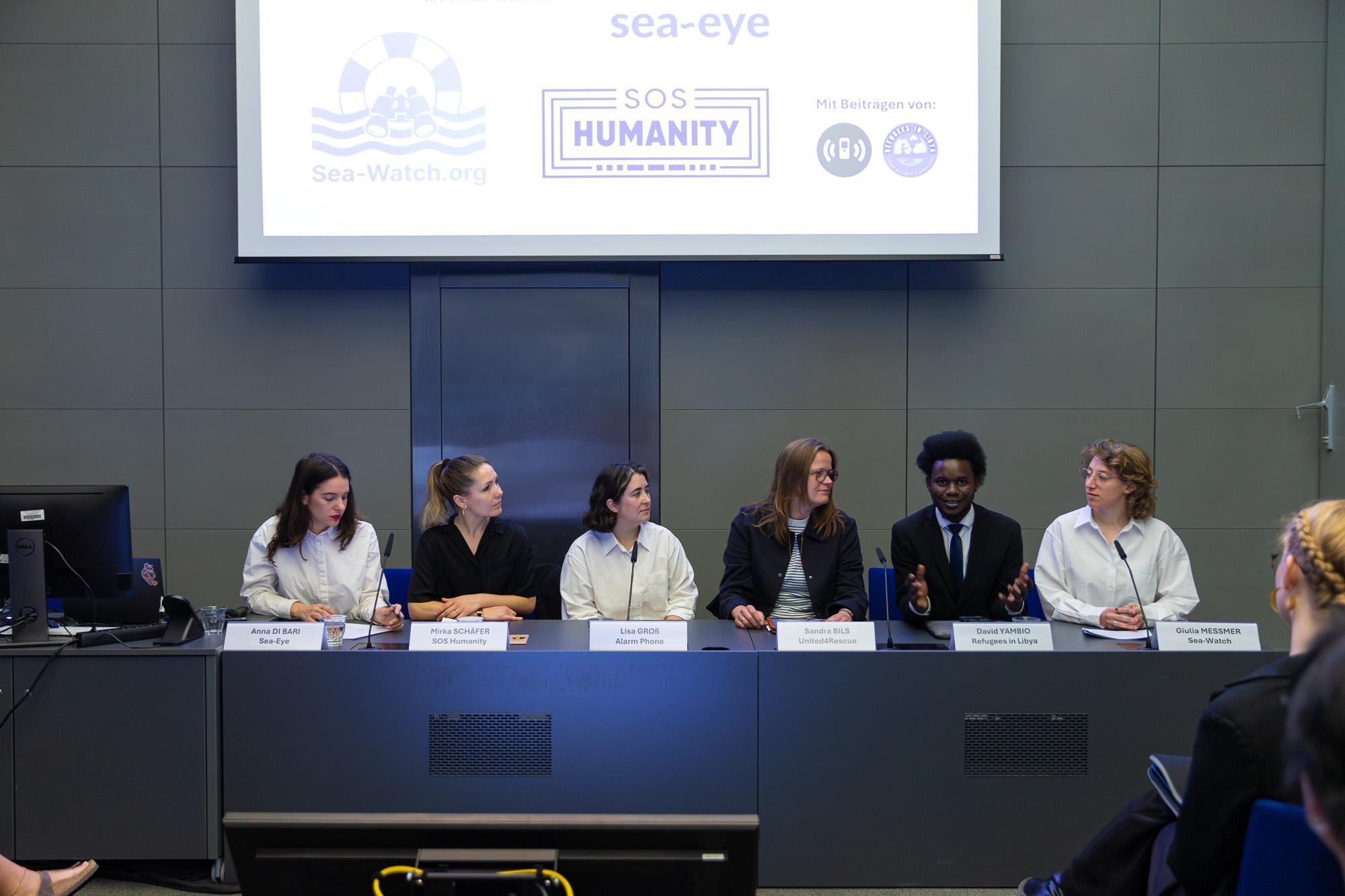
Photo from the press conference in Berlin. Source: Alarm Phone
On the same day, the World Refugee Day, the Tunisian Association FTDES published a statement, remembering the suffering of millions who have been forcibly displaced from their homes by war, tyranny, climate change, and discrimination. In Tunisia, they denounced a systematic policy of racism and repression towards refugees, asylum seekers, and all displaced persons.
Also on the same day, Refugees in Libya, together with other associations, launched a campaign against the renewal of the Italy-Libya Memorandum of Understanding, signed in 2017, which leads to daily rape, torture, detention, and killing of thousands of people.
On 24 June, the European Commission President Ursula von der Leyen announced the launch of a new European mission to Libya aimed at exploring new arrangements for cooperation to halt illegal migration flows from the country’s coasts. She explained that the mission would engage with authorities in both eastern and western Libya.
On 25 June, 71 refugees coming from Libya thanks to the Humanitarian Corridor of UNHCR Italy, ARCI and Sant’Egidio landed in Rome and were welcomed in Italy.
On the same day, it was reported that Greece, in coordination with European partners and Libyan authorities, had sent navy vessels off the Libyan coast to prevent migrants from reaching its territory. Greece’s prime minister described the move as necessary to deter human traffickers.
On 26 June, Sea-Watch reported that a day before, their monitoring aircraft crew sighted three bodies floating in international waters off Libya. On a second flight, they discovered two more. A Libyan militia boat, funded by Italy, was nearby but refused to respond to calls. The bodies were not recovered by authorities. Some days later, Life Support, a rescue ship of the Italian NGO Emergency, went there, took the dead bodies on board and brought them to Italy.
On the same day, Alarm Phone was alerted to two boats that had fled from Tunisia. One boat carrying 37 people remained missing. The other one with 45 people on board was returned to Tunisia. Survivors were brought to the Algerian border and beaten up.
On 27 June, 44 people in distress in the Maltese/Italian SAR zone alerted Alarm Phone. They had been at sea for six days already and had no water left. The Italian Coastguard reacted to our alert, rescued the people and brought them to Pozzallo, Sicily.
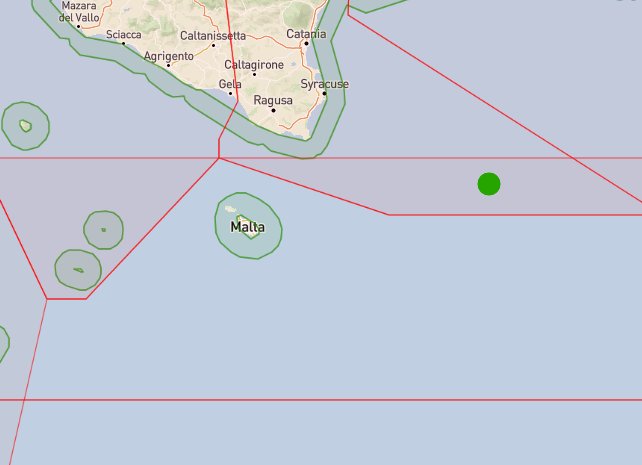
Map showing the position of the boat in distress. Source: Alarm Phone
On the same day, Alarm Phone was alerted about a boat with around 40 people on board who had fled from Qarabulli, Libya. Authorities were alerted. Later we learned that the group was intercepted and brought to a detention center in Libya.
On 28 June, Alarm Phone published a report about deportations to the desert. Since the Tunisian government escalated its violence against Black people on the move in spring 2025, we were again and again alerted to such deportations, resulting in death and disappearance.

Journey according to the testimony given. Photo: Alarm Phone